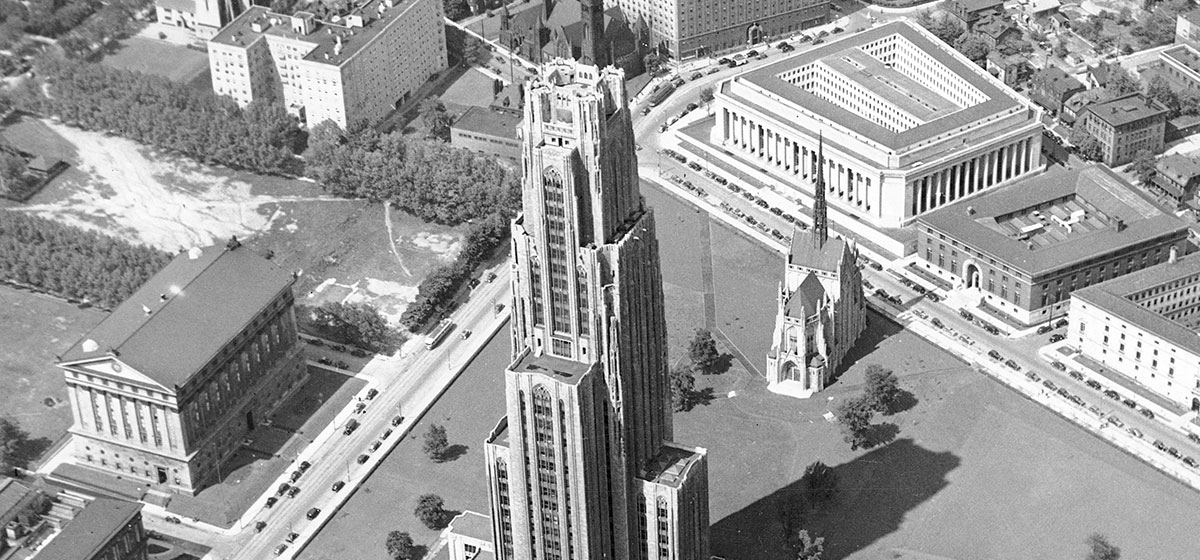
On October 2, 1908, toward the close of Pittsburgh’s 150th anniversary celebration, a crowd of dignitaries, distinguished guests and assorted politicos congregated in Oakland, an island of pastoral villas and classical architecture in the middle of the growing, smoky metropolis.
The crowd came to see the groundbreaking for Soldiers’ and Sailors’ Memorial Hall, a cavernous Beaux-Arts civic center designed by Henry Hornbostel, the New York-bred architect who had designed the brand-new campus of the nearby Carnegie Technical Schools (now Carnegie Mellon University). They then proceeded to another groundbreaking, a few feet away, to see the cornerstone for the beginning of another Oakland campus. The Western University of Pennsylvania was moving to the area. The school (its name would soon become the University of Pittsburgh) was then located on Observatory Hill, and within a year its relocation to Oakland would be complete.
With the mayor, governor and U.S. vice president Charles W. Fairbanks in attendance, Chancellor Samuel Black McCormick tapped a hammer to the cornerstone of the campus’s first building, the School of Mines, and said: “For the glory of God, for the uplifting of humanity, for the conquest of this earth, in the name of true science and sound learning, I now declare this cornerstone well and truly laid.” Pitt, as the school would later be called, was in Oakland.
Over the ensuing century, the university would become a source of enlightenment, culture, employment and, on a few occasions, agitation for the neighborhood surrounding it.
Because of Pitt, Oakland is the state’s “third largest downtown,” with 50,000 people streaming into the neighborhood to work, study or just look around. Its streets have borne the tread of the world’s best and brightest. Famously, the polio vaccine was invented in Oakland. Great strides in organ transplantation—a messy, dangerous, daring procedure—were made there. A legion of legendary athletes—Mike Ditka, Dan Marino, Tony Dorsett among them—honed their craft in Pitt Stadium. In short, Pitt and Oakland have become synonymous and inseparable.
That may explain why, 100 years into their relationship, many might see the centennial banners along Fifth Avenue (“Pitt: Celebrating 100 years in Oakland”) and wonder, “Was there ever anything in Oakland before Pitt?”
The short answer to this question is “Yes. Sort of.”
Throughout the 19th century, the Oakland plateau was a pastoral refuge for the wealthy, especially those escaping the cholera epidemics that swept through the Golden Triangle, three miles to the west. As the city grew in the late 19th century, Oakland remained largely undeveloped. That’s because most of it belonged to Mary Schenley, an expat heiress who balked at selling land that had been passed to her from her grandfather, General James O’Hara. As a teenager, Mary eloped to England with her husband, a twice-widowed Capt. Schenley, 24 years her senior. Though she spent most of her life in Europe, she remained loyal to her hometown. In 1889, she donated 400 acres to the city for a park in her name.
The Schenleys gradually sold off parcels, which city fathers used to create “a second Pittsburgh.” At the time, the “first Pittsburgh” was synonymous with smoke, squalor and vice, as exposed in The Pittsburgh Survey (1907) and the muckraking reports of Lincoln Steffens. Beginning with Andrew Carnegie’s Library and Institute, and later his Technical Schools (CMU), a series of neo-classical structures went up around Oakland, beckoning thoughts of long-gone civilizations: Venetian Renaissance (Pittsburgh Athletic Association), the Islamic caliphate (Masonic Temple, Fifth Avenue), and the Byzantine empire (Webster Hall). The Schenley Hotel (now the William Pitt Student Union) instantly became the city’s finest hostelry. In the words of one local scribe, the neighborhood had taken on “a decidedly distinguished air,” where “men of education and discernment would wield at least a quiet influence in molding and refining public thoughts.”
To this rarefied district came the University of Pittsburgh. The school’s campus, designed by Hornbostel, was envisioned as an acropolis, a kind of city on a hill. For better or worse, the design was never fully implemented. Instead, an ambitious chancellor named John Bowman dreamed of constructing a “tall building” on land then known as Frick Acres, which would house badly needed classroom space for men returning from World War I. Even into the ‘20s, the land was mostly open space, used occasionally to house a circus coming through town.
Bowman spent years acquiring land, raising money and convincing the school’s traditionally conservative trustees that the tall building was necessary. Bowman got 97,000 schoolchildren to donate a dime; the $9,700 he raised didn’t make much of a dent in the capital campaign, but thepublicity it elicited was priceless.
“People forget what he had to go through to build this tower,” says Maxine Bruhns, director of the Nationality Rooms at the Cathedral of Learning, the eventual name for Bowman’s “Tall Building.” She is as close as it gets to a school historian. “People said ‘How can you build a tower that high?’ They thought students were going to fall out of windows or the wind would blow it down.”
“A lot of people thought it was crazy to build a college building 42 stories high,” says J. Quint Salmon, (class of 1928, Law School 1931), a retired Beaver County judge, who went to Pitt while the building was under construction. “Bowman, he had the idea that nobody would forget where the University of Pittsburgh was, and he was right.”
The academic skyscraper would be a beacon to the sons and daughters of the region, a metaphor for the heights towhich a proper education could propelthe local populace. “The new building,” Bowman said, “is to express that spirit of achievement with such force and sublimity that the whole world will understand.” Robert C. Alberts, who wrote a history of the school, called the building “the most important single event in the history of the university.” The final design came during a late-night brainstorm session while Bowman and the architect, Charles Klauder, listened to a phonograph recording of Wagner’s Die Walküre.
Work began in 1926, with a foundation that sank 60 feet into a bedrock of Birmingham Shale, 40 feet thick. By 1931, classes began moving to the tower. Bowman soon ordered the creation of the Nationality Rooms, giving many of the region’s immigrant groups—one-third of all students were either foreign-born or children of immigrants—a room to call their own. Ruth Mitchell, the first director of the rooms (Bruhns is the second) said the creation of the Nationality Rooms was “the first time that any university… recognized the immigrant groups as bringing something other than industrial brawn—that they, too, had a cultural heritage which they would like to share.” (Bruhns maintains the cathedral houses the university’s only known ghost, in the Early American room.)
Under Bowman, another unmistakable feature of the university, its medical center, was born. The university’s medical school actually began in 1886 as a small, private school started by doctors in Polish Hill, says Barbara Paull, who wrote a history of the medical school. It later joined the university, but by the 1920s, its administrators bemoaned a lack of teaching hospitals—places where students could learn from actual patients, and where faculty could conduct research. The school entered into agreements with several hospitals—Magee, Presbyterian, Eye and Ear, Montefiore and Children’s. They built new hospitals near campus, clustered on Oakland’s “Cardiac Hill.”
The medical school rose to prominence in the 1950s, when Jonas Salk, a recent hire at Pitt’s medical school, initiated an ambitious research program to eradicate Polio. “You have to understand, people were terrified of having their kids get polio,” says Paull. FDR had had polio. Parents wouldn’t let their children swim in late summer for fear of catching the virus that caused the disease. “Salk had these public trials to test the vaccine. They got tremendous publicity—and it worked. He was a folk hero.” At the same time, the medical school was invigorated with a $15 million donation from the Mellon family, the biggest donation the school had ever received.
In 1981, another star recruit came to Oakland to push medical advances farther. Thomas Starzl, a pioneer liver transplant surgeon, performed the world’s first double transplant (liver and heart) at Pitt, a saga that thrust the university’s medical center into the national spotlight. The Institute that now bears his name remains one of the leading transplant centers in the world.
It wasn’t until the 1980s that the school’s now conspicuous research acumen began to ramp up. The university started a new type of shared management with its teaching hospitals. The hospital management organization was independent from the university but maintained an inter-dependent relationship that ensured hospital revenues were poured back into the university’s research programs. What was good for one became good for the other. The organization went through several names and, in 1990, took the name now familiar to anyone in Western Pennsylvania: the University of Pittsburgh Medical Center.
UPMC trimmed hospital costs, consolidated operations and eventually took over a score of hospitals in the region. It’s now a $7 billion global health behemoth, with operations in Italy, Ireland, England and Qatar. UPMC is the region’s largest employer; it is a major part of the region’s economic turn to health care after the demise of heavy industry. Fittingly, UPMC’s logo now graces Pittsburgh’s tallest building, the U.S. Steel Tower.
Its revenues have helped set up the university’s equally gargantuan research apparatus. Pitt’s various health science schools take in $456 million a year in National Institutes of Health research grants, making it the sixth highest grant recipient in the country. Pitt’s newest research building, Biomedical Research Tower 3, is the most recent example of this prowess. The $200 million, 10-story tower is equipped with some of the most advanced lab equipment in the world.
The key to the medical research juggernaut in Oakland is the separate yet intertwined structure of Pitt and UPMC, says Arthur Levine, Pitt’s senior vice chancellor for health sciences and dean of the School of Medicine, which now boasts a faculty of 2,000. “It’s meant a lot of money, a lot of jobs, a lot of research and a lot of health care, which has in turn meant more jobs.”
All along, the neighborhood around campus has grown and adapted to its largest tenant. The neighborhood to the west and south of campus was once home to many steelworkers who walked down the city staircase to the J & L plant along Second Avenue. It was a neighborhood of immigrants: Irish, Polish, Italian, Greek. Even into the 1960s, you could still see elderly Italian ladies walking Bouquet Street or Oakland Avenue dressed in widow’s black, the same as in the old country. There was a German bakery, a Greek restaurant called the Black Angus (specialty: Fish Plaki and Turkey Devonshire), and a Jewish deli. Oakland, to the west of campus along Forbes and Fifth Avenues was home to jewelry stores, hardware stores and shoe repair shops.
The Electric Banana, the Decade, King’s Court, Jay’s Bookstall and the Syria Mosque offered culture, high and low. Duquesne Gardens hosted boxing, hockey and roller skating. Some of these businesses and hangouts faded away. Others were pushed out by rising rents.
By the 1950s, Chancellor Edward Litchfield began drawing up new plans to reflect the school’s desire to be “a greatuniversity.” Among these plans was a bold design to fill in Junction Hollow, between Pitt and Carnegie Mellon, with the equivalent of a 150-story skyscraper, laid on end. That plan never came to fruition.
Real strain between town and gown came when the university fell into economic disarray in the 1960s. Faced with bankruptcy, Pitt was bailed out by the state. In the process, Pennsylvania absorbed Pitt as a “state-related,” “quasi-public”institution. With more state money, in-state tuition shrank by two-thirds. Enrollment doubled in six years. Suddenly, the university was packed to the gills, renting out space in the Oakland business district. Rents went up, and never went back, says Sandra Phillips, executive director of Peoples Oakland, a community group that formed in the late 1960s in response to the university’s expansion plans.
“The university grew very large, very fast,” says Phillips. “It was the size, the speed of it that people were worried about. They were worried they’d lose their homes. And some of them did.”
By the early ’70s, the state was planning a $100 million campus makeover to accommodate the school’s growth. More than just money, the state offered the university the muscle of eminent domain, which it eventually used to expand the campus. Among the victims of the university’s growth was Forbes Field, longtime home of the Pirates and site of Bill Mazeroski’s walk-off shot that ended the 1960 World Series. Over howls of protest, the school demolished the field (but kept part of the outfield wall) and in its place built a pair of academic buildings, examples of the largely regrettable brutalist school of architecture. The university was planning to expand further into Oakland, but agreed to stop after a successful local campaign against it.
“They were really hated by a lot ofpeople in the neighborhood, and for a lot of good reasons,” says Sabina Deitrick, an associate professor at the University Center for Social and Urban Research who has studied Pitt’s relationship with Oakland. The school eventually learned to deal with its neighbors, but many of them are no longer there. Owing to university expansion, real estate speculation and urban flight to the suburbs, only 16 percent of Central Oakland residences were owner-occupied by 1990.
Still, Deitrick says, the university has gone to great lengths to be morecooperative and thoughtful about how it deals with those around it. Pitt might still be “an 800 pound gorilla,” Deitrick says, but it’s learned to be a nicer one.
“We’ve been working very hard over the years to improve these relationships,” says Robert Hill, vice chancellor forpublic affairs. “We don’t take the view that we have some kind of manifest destiny or divine rights. We work through the issues and try to resolve them withthe community.”
Hill is quick to point to the university’s community-oriented programs that provide health, education and athletics to low-income residents in the nearby Hill District and around the county, asexamples of Pitt’s commitment to being a good neighbor. And it’s difficult to overstate the university’s importance and contribution to the region. The school generates $1.5 billion to the local economy, through its 11,000 employees and the 32,000 total jobs and businesses it supports.
Under Chancellor Mark Nordenberg, who took the top post in 1995, the school has accelerated its ascension, for the first time climbing into the U.S. News & World Report’s Top 20 in public research universities. The university is attracting more top students: 43 percent of itsincoming freshman scored in the top 10 percent of their high school class in 2007, as opposed to just 19 percent in 1995. Nordenberg’s ambitious $500 million capital campaign turned into a $1 billion and then a $2 billion fundraiser, making it one of the biggest in the country.
The money will go to fund scholarships, faculty appointments, and yes, newfacilities for all those students and professors. The story of Pitt in Oakland might just be beginning.




